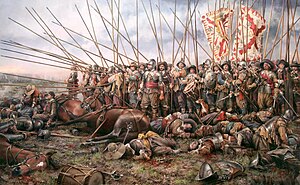Ten Years' War
This article is incomplete because it is pending further input from participants, or it is a work-in-progress by one author. Please comment on this article's talk page to share your input, comments and questions. Note: To contribute to this article, you may need to seek help from the author(s) of this page. |
| Ten Years' War | |||||||
|---|---|---|---|---|---|---|---|
 A Narozalic army overlooking the battlefield after the Battle of Brambauer, 1712 | |||||||
| |||||||
| Belligerents | |||||||
|
| ||||||
| Commanders and leaders | |||||||
|
| ||||||
| Strength | |||||||
| |||||||
The Ten Years' War was a war in Northern and Central Euclea between 1711 and 1721. It was one of the largest wars up until that point and included many of the forefront powers in Euclea, including the Narozalic Empire, Sunrosian Monarchy, much of the Ahnemunde Confederation, Estmerish Commonwealth, and later, the Gaullican Empire. The war began as the rulers of Narozalica and the Sunrosian Monarchy signed an alliance which backed each others' claims in the Duchies of Velzemia and western Werania and Estmere respectively. Much of the war would be fought in the Ahnemunde, western Estmere and the latter stages in northern Gaullica. The war was particularly devastating in Estmere, where many towns and villages were razed, their inhabitants removed or killed and vital infrastructure was lost. The effects of the war would go on to influence the Estmerish Civil War and, more broadly, the Euclean Spring.